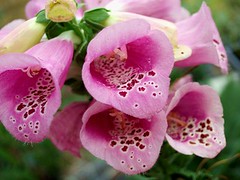
I think the most beautiful of all the herb flowers is foxgloves. It's an herb? you may ask. Absolutely. Digitalis purpurea is the source of the potent heart medication digitalis. But potent heart medications are dangerous and all parts of the foxglove plant should be considered poisonous. I always make sure my customers know this before they leave with these plants in hand.
Foxgloves are biennials, nearly all of them following the biennial pattern of not flowering until the second year. For those of us in Florida, this means foxgloves are rarely attempted as it is very difficult to get them though the first summer's heat and humidity. The pictured foxglove is a variety called "Foxy" and will flower the first year, allowing us to grow it as an annual.
Foxgloves are the quintessential fairy garden plant and were used for one of Cicely Mary Barker's flower fairies. The spots are like little stepping stones which say to bees "Come this way, the good stuff is in here".

This intensely fragrant plant is Tagetes lemmonii with the common names lemon marigold, copper canyon daisy and mountain or lemmon's marigold. Of all the plants I've ever had in my garden, this one releases the most noticeable fragrance when barely touched or watered. Kind of a funky smell, some say a lemon scent; but the species name lemmonii comes from the botanical explorer J G Lemmon who discovered it in its native Arizona.

These flowers look similar to the ones above which is no surprise since this plant is the close relative Tagetes lucida. Commonly called Mexican mint marigold, it is used like tarragon in this area and so is also found sold under the common names Mexican, Texas, Spanish, tropical or winter tarragon.
True French tarragon (Artemisia dracunculus) is impossible to grow in Florida. It hates our hot humid summers and requires several months of dormancy brought on by winter freezing. If you live here in Florida and buy fresh tarragon in those little packages at the grocery store, you may have been using this tarragon all along. The fresh tarragon sold in our local grocery stores is nearly always this type since most of our local herbal produce is grown in south Florida.
Mexican tarragon is not as peppery as French tarragon and has more of an anise flavor, but it makes a great substitute. I add it to my homemade tartar sauce.



No comments:
Post a Comment